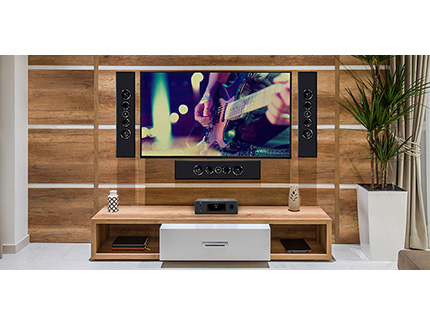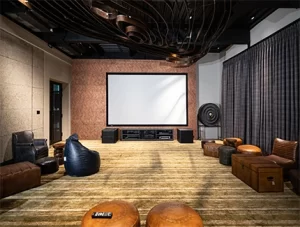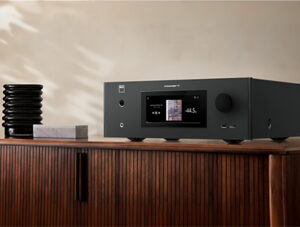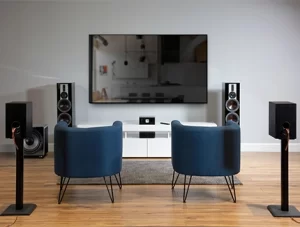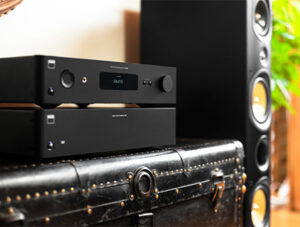In today’s modern world, home entertainment has increasingly become a central focus for many households. With advancements in technology, it is now easier than ever to create a truly immersive and high-quality audiovisual experience right in the comfort of your own living room. One essential component that can help take your home entertainment setup to the next level is a multi-channel AV receiver.
A multi-channel AV receiver serves as the central hub for all of your audio and video components, allowing you to seamlessly connect and control various devices such as televisions, Blu-ray players, gaming consoles, and speakers. By harnessing the power of a multi-channel AV receiver, you can enjoy a truly cinematic experience with surround sound capabilities that will make you feel like you are right in the middle of the action. Additionally, these receivers often come equipped with advanced features such as 4K compatibility, HDR support, and streaming capabilities, providing you with endless options for enhancing your home entertainment experience.
Understanding the key features of a multi-channel AV receiver
A multi-channel AV receiver is an essential component for any home entertainment system, providing the backbone for high-quality audio and video playback. Understanding the key features of a multi-channel AV receiver is crucial in order to maximize your entertainment experience.
One of the main features of a multi-channel AV receiver is its ability to decode and process audio signals from various sources. This includes decoding surround sound formats such as Dolby Atmos, DTS:X, and Auro-3D, allowing for immersive sound experiences that envelop the listener. The receiver also has built-in digital signal processing (DSP) capabilities to optimize audio performance based on the room acoustics and speaker configuration.
Another important feature of a multi-channel AV receiver is its amplification capabilities. The receiver has multiple channels of built-in amplification, typically ranging from 5 to 11 channels. This allows for driving a complete home theater speaker system, including front, center, surround, and height speakers, for a truly immersive audio experience. The receiver also has the ability to bi-amp certain speakers, providing more power to drive them effectively.
In addition to audio processing and amplification, a multi-channel AV receiver also serves as a central hub for video sources. The receiver has multiple HDMI inputs and outputs, allowing for seamless switching between different video sources such as Blu-ray players, gaming consoles, and cable/satellite boxes. The receiver also features video upscaling and pass-through capabilities, ensuring that the video signal is output in the highest quality possible to the display device.
Furthermore, a multi-channel AV receiver provides various connectivity options for integrating with other audio/video components in the home entertainment system. This includes Ethernet and Wi-Fi connectivity for streaming music and videos from online services, as well as Bluetooth and AirPlay for wireless audio streaming from mobile devices. The receiver also has USB inputs for playing music files from external storage devices, and supports various streaming protocols such as DLNA and Spotify Connect.
Lastly, a multi-channel AV receiver offers advanced calibration and setup features to optimize the audio performance in any listening environment. The receiver typically includes a built-in microphone and room correction software, allowing for automatic speaker calibration to ensure proper speaker levels, distances, and frequency response. Some receivers also feature advanced room correction technologies such as Audyssey MultEQ and Dirac Live, which further optimize the sound quality based on the room acoustics.
In conclusion, understanding the key features of a multi-channel AV receiver is essential for creating a truly immersive and high-quality home entertainment experience. From audio processing and amplification to video switching and connectivity options, the receiver serves as the central hub for bringing together all the components of a modern home theater system. By selecting a receiver with the right features and capabilities, you can transform your living room into a true entertainment oasis.
Setting up your multi-channel AV receiver for optimal performance
Investing in a multi-channel AV receiver is a great way to enhance your home entertainment experience. These receivers allow you to connect multiple audio and video sources, creating an immersive sound and visual experience that replicates a cinematic atmosphere in your own living room. However, in order to fully maximize the potential of your AV receiver, it is important to properly set it up for optimal performance.
The first step in setting up your multi-channel AV receiver is to carefully read the user manual that comes with the product. This manual will provide detailed instructions on how to connect the receiver to your audio and video sources, as well as how to configure the settings for the best sound and visual quality. Make sure to follow these instructions closely in order to ensure that your receiver is properly set up.
When connecting your audio and video sources to the AV receiver, it is important to use high-quality cables to ensure that you are getting the best possible sound and picture quality. Make sure to use cables that are compatible with the inputs and outputs on your receiver, as using the wrong cables can result in a poor quality audio or visual signal.
Once you have connected all of your audio and video sources to the receiver, it is time to configure the settings for optimal performance. Start by running the receiver’s auto-calibration feature, which will analyze your room’s acoustics and automatically adjust the sound settings for the best possible audio quality. This feature will help to optimize the sound quality based on the layout of your room and the placement of your speakers.
After running the auto-calibration feature, you can further fine-tune the sound settings by adjusting the equalizer settings on the receiver. This will allow you to customize the sound to your personal preferences, whether you prefer a more bass-heavy sound for action movies or a more balanced sound for music playback. Experiment with different equalizer settings until you find the perfect sound for your home entertainment system.
In addition to adjusting the sound settings, it is also important to configure the video settings on your AV receiver for optimal performance. Make sure to set the resolution to match the capabilities of your TV or projector, and adjust the color, brightness, and contrast settings to achieve the best possible picture quality. You may also want to enable features such as dynamic range control or video upscaling to further enhance the visual experience.
Finally, don’t forget to properly place and calibrate your speakers for the best sound quality. Make sure that the speakers are positioned at ear level and that they are evenly spaced around the room to create a balanced sound field. You can use the receiver’s built-in speaker calibration feature to further fine-tune the sound quality and ensure that all of your speakers are working together to create a seamless audio experience.
By carefully following these steps and taking the time to properly set up your multi-channel AV receiver, you can ensure that you are getting the best possible sound and visual quality from your home entertainment system. With a little bit of effort and attention to detail, you can create a truly immersive home theater experience that rivals the quality of a commercial movie theater.
Exploring the benefits of a multi-channel AV receiver for home entertainment
When it comes to creating an immersive and powerful home entertainment experience, a multi-channel AV receiver is an essential component that can take your audio and video quality to the next level. By routing audio and video signals from multiple sources to your speakers and display device, a multi-channel AV receiver provides a centralized hub for all your home entertainment needs.
One of the key advantages of a multi-channel AV receiver is its ability to support multiple channels of audio output. This means that you can enjoy surround sound formats like Dolby Atmos and DTS:X, which create a more realistic and enveloping audio experience by not only delivering sound from the front and sides but also from above and behind you. With a multi-channel AV receiver, you can truly feel like you are in the middle of the action, whether you are watching a movie, playing a video game, or listening to music.
In addition to supporting advanced audio formats, a multi-channel AV receiver also offers a high level of flexibility and customization. Most modern receivers come equipped with a variety of audio and video inputs and outputs, allowing you to connect multiple devices such as Blu-ray players, gaming consoles, streaming devices, and more. This means that you can easily switch between different sources without having to constantly unplug and reconfigure cables.
Furthermore, many multi-channel AV receivers come with advanced audio processing capabilities that allow you to fine-tune your sound to suit your preferences. From adjusting the volume levels of individual speakers to applying room correction algorithms that optimize sound quality based on the acoustics of your room, a multi-channel AV receiver gives you the tools you need to create a personalized audio experience that is tailored to your specific tastes.
Another benefit of a multi-channel AV receiver is its ability to upscale and enhance the video quality of your content. Many receivers feature technologies like 4K upscaling, HDR (High Dynamic Range) support, and video processing algorithms that can improve the clarity, color accuracy, and contrast of your video playback. This means that whether you are watching a Blu-ray disc, streaming content from a service like Netflix, or playing a video game, you can enjoy a visually stunning and immersive viewing experience that rivals what you would see in a movie theater.
Overall, a multi-channel AV receiver is a crucial component for maximizing your home entertainment experience. With its support for advanced audio formats, customizable features, and video enhancements, a multi-channel AV receiver can transform your living room into a high-end home theater that delivers unparalleled audio and video quality. Whether you are a movie buff, a music lover, or a gamer, investing in a multi-channel AV receiver is sure to take your home entertainment setup to the next level.
Tips for selecting the right multi-channel AV receiver for your needs
When it comes to selecting the right multi-channel AV receiver for your home entertainment system, there are several important factors to consider to ensure you are getting the best experience possible.
First and foremost, consider the number of channels you need. Multi-channel AV receivers come in various configurations, ranging from 5.1 to 11.2 channels. The number of channels you need will depend on the size of your room, the layout of your speakers, and your personal preferences. For example, a 5.1 channel system is great for smaller rooms, while a 7.1 or 9.1 system is better suited for larger spaces or those looking for a more immersive audio experience.
Next, think about the power output of the AV receiver. The power output, measured in watts per channel, will determine how loud and clear your audio will sound. Consider the size of your room and the power requirements of your speakers when choosing an AV receiver with the right amount of power for your needs.
Another important factor to consider is the connectivity options. Make sure the AV receiver you choose has enough HDMI inputs for all of your devices, such as your Blu-ray player, gaming console, and cable box. Additionally, consider whether you need features like built-in Bluetooth or Wi-Fi for streaming music from your phone or computer.
It’s also important to consider the audio formats supported by the AV receiver. Look for a receiver that is compatible with the latest audio formats, such as Dolby Atmos and DTS:X, for a more immersive surround sound experience. Additionally, consider whether the receiver supports HDR and 4K video passthrough for the best video quality.
In addition to these technical features, consider the user interface and ease of setup of the AV receiver. Look for a receiver with a user-friendly interface and setup process, as this will make it easier to adjust settings and customize your audio experience. Some receivers also come with room calibration software that helps optimize the sound quality based on the acoustics of your room.
Lastly, consider your budget when choosing a multi-channel AV receiver. There are receivers available at a wide range of price points, so make sure to set a budget and stick to it while still getting the features you need for the best home entertainment experience.
In conclusion, selecting the right multi-channel AV receiver for your home entertainment system involves considering factors such as the number of channels, power output, connectivity options, audio formats supported, user interface, and budget. By taking these factors into account, you can maximize your home entertainment experience and enjoy immersive audio and video playback for years to come.
Troubleshooting common issues with a multi-channel AV receiver
As a homeowner looking to maximize your home entertainment experience with a multi-channel AV receiver, it is important to be prepared for common issues that may arise when using this complex piece of technology. Troubleshooting these issues can help ensure that you are able to fully enjoy the capabilities of your AV receiver without any interruptions.
One common issue that many users face with multi-channel AV receivers is poor audio quality. If you are experiencing muffled or distorted sound coming from your speakers, it may be due to improper speaker placement or incorrect settings on the receiver. Ensure that your speakers are positioned correctly in relation to your listening area and that all speaker wires are properly connected to the receiver. Additionally, check the audio settings on your receiver to ensure that they are optimized for your specific setup.
Another common issue that users encounter is a lack of video output from the receiver to the TV or projector. If you are not seeing any video feed on your display, it may be due to a faulty HDMI cable or incorrect input settings on the receiver. Make sure that all HDMI cables are securely connected to both the receiver and the display device, and double-check the input settings on the receiver to ensure that the correct input source is selected.
If you are experiencing issues with your multi-channel AV receiver overheating or shutting off unexpectedly, it may be due to poor ventilation or excessive dust buildup inside the receiver. Ensure that your receiver is placed in a well-ventilated area with plenty of space around it to allow for proper airflow. Additionally, periodically clean out any dust or debris that may have accumulated inside the receiver to prevent overheating.
Intermittent connectivity issues between the receiver and external devices, such as streaming media players or gaming consoles, are also common with multi-channel AV receivers. If you are experiencing problems with devices disconnecting or losing signal, it may be due to outdated firmware on the receiver or incompatible devices. Check for firmware updates for your receiver and connected devices, and ensure that all devices are compatible with each other for seamless connectivity.
In the event that you are still unable to troubleshoot and resolve these common issues with your multi-channel AV receiver, it may be necessary to consult the user manual or contact the manufacturer for further assistance. Many manufacturers offer customer support services to help troubleshoot and resolve technical issues with their products. By following these troubleshooting tips and seeking help when needed, you can ensure that you are able to fully maximize your home entertainment experience with a multi-channel AV receiver.
Conclusion:
Investing in a multi-channel AV receiver is essential for maximizing your home entertainment experience. With its ability to support various audio and video formats, deliver immersive sound quality, and seamlessly connect to multiple devices, a multi-channel AV receiver offers the flexibility and performance needed to create a truly immersive viewing and listening experience in your home. Whether you are watching movies, playing video games, or listening to music, a multi-channel AV receiver will elevate your entertainment setup to new heights. Upgrade your home entertainment system today and enjoy the ultimate audio-visual experience.

